Before the J Class yachts came into existence, yachts were designed to be bigger and bigger. The towering rigs of the Big Boat Class such as ‘ Lulworth ’ and ‘ Britannia ’ dwarfed all other yachts. The late 1920s heralded discussion and agreement of the Universal Rule. This new formula controlled the size and displacement of the new yachts, enabling them to be raced as evenly as possible. Almost immediately, designs were being commissioned for the new, massive ‘Bermudan rigs, with no bowsprits’.
The rule was based on ideas proposed by Nat Herreshoff allowing waterline length to be increased without sail area being restricted, as it had been under the International Rule. This was compensated by a larger displacement and so draught was limited to 15ft.
In 1929 Sir Thomas Lipton, owner of Lipton’s famous for his import of Lipton Tea from India, issued his fifth challenge to the Americans for the America’s Cup. He commissioned the build of the first J Class Yacht which signified the start of a new era in design evolution and racing. On each occasion he challenged for the America’s Cup as a member of the Royal Ulster Yacht Club in Northern Ireland. RUYC are still involved with The Cup – presenting the Royal Ulster Cup to the Club of the winning challenger.
The Universal Rule came into effect in 1930. The size of a yacht was determined (by waterline length) and this was shown as an alphabetical list. “J” signified yachts with a waterline length of between 75 to 87 feet. The addition of the new design Bermuda mast allowed the yachts to carry a huge sail plan. Nothing so large and ‘awesome’ had been built previously. The Americans had a distinct advantage over Britain in the 1930 America’s Cup. They had the money to build four J’s over Britain’s one, yet the British yacht, Shamrock V was a hot contender. She was designed by Nicholson and built at the family yard in 1930, and before she crossed the Atlantic to attend the Cup she had notched up more than 700 sea miles (1,296km), won 15 out of the 22 races she had entered and had been tweaked and tested to a high degree.
In answer to Lipton’s challenge of 1929 the Americans designed four J-Class yachts as possible defenders. Enterprise, Whirlwind, Yankee and Weetamoe were launched within a month of each other; Weetamoe and Enterprise from the Herreshoff yard and Yankee and Whirlwind from Lawley & Son’s yard in Bristol.
Whirlwind, the second J, was the most revolutionary of the four. Francis L Herreshoff had moved away from conventional yachts and designed a boat, which took the new rule to its extreme. Whirlwind combined many new ideas and Herreshoff experimented with hull shape and rig. She was the longest of the early J’s at 86ft on the waterline and remained so until Ranger and Endeavour II were built in 1937.

She was built of semi-composite construction (the other three American Js were built out of the highly expensive Tobin bronze), was double-ended and had a permanent backstay. Uffa Fox described her profile as: “Very pleasing to the eye, the stem sweeping down to the keel in a very sweet line, and to a man who, like myself, believes that a pointed stern is a logical ending for all vessels, her stern is a joy to behold.” He predicted, “If the Yacht Racing Rules govern well and wisely, we shall see Whirlwind racing 50 years hence. If they do not she will probably be cruising then.” But Whirlwind met an early demise. Her building was delayed as she didn’t meet Lloyd’s A1 scantling rules and she wasn’t chosen to be the 1930s defender. She was often out-performed when close hauled, her steering gear making her difficult to steer. She was eventually scrapped along with Enterprise in 1935. However, her unusual double-headsail rig was later adopted by the rest of the Js.
The third American J, Yankee, was the best all-rounder. At 84ft on the waterline and 125ft length overall, she was solidly made of Tobin bronze and was extremely well balanced. Designed by Frank Paine , Yankee had an almost straight sheerline and easy lines. She was a powerful contender for defender, but not fine-tuned enough to succeed. She did, however, take part in the 1934 America’s Cup trials and with alterations to her rig, to carry more sail, and bow, which was lengthened and made more of a V-shape, she then proved more successful, especially in light winds.
The fourth of the American J’s was Weetamoe, which was designed by Clinton Crane and was the narrowest of the early four. Despite claims that Yankee was the best all-rounder, Weetamoe is said to have been the closest rival to Enterprise to be the Cup defender. Charles Nedwick, in Ian Dear’s book Enterprise to Endeavour, describes Weetamoe as having a profile “that is practically a triangle, with a straight line from the after end of the waterline to the bottom of the keel and thence a line which is slightly convex, and then slightly concave to the forward end of the waterline.” In an attempt to better performance and make her less tender, her profile below the water was radically altered in 1934 with a new contour and bulb keel. The alterations failed and not long afterwards were reversed. In common with the other J’s, she had about 43ft of overhang and her hull, Nicholson opined, “was the best of all the US Js”.
When Shamrock V and Enterprise eventually met off Newport, Rhode Island, later that year, the two J’s were well matched in hull profile, but differed significantly in rig. Enterprise’s rigging was lighter, she had the Park Avenue boom, which was so advantageous to windward, and had lots of winches on board. Shamrock V meanwhile, was under-winched and hard work to sail. She has since, however, proved her success in that she is still sailing today.
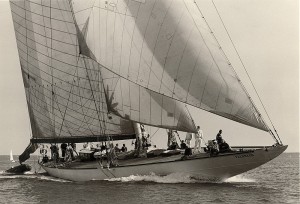
The sixth J-Class yacht to be built, and the second built on British soil was Velsheda . She was the only J not built as a contender for the America’s Cup. Her owner, WL Stephenson, who previously owned White Heather II, the 23-Metre converted to rate as a J-Class in 1930, had Velsheda built in steel in 1933 at the Camper & Nicholson yard. Velsheda was a great success. In 1935 she was significantly altered, her bow was snubbed around the waterline and her stern improved. The following season she won the King’s Cup at Cowes Week.
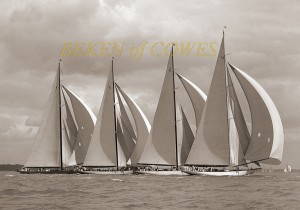
In 1934, Sopwith challenged for the America’s Cup. His challenger was Endeavour . She was Charles Nicholson’s third J-Class design and he said of her “She will have quite a normal hull… because I have thought it right to suppress possible experimental form, which would be most interesting to try out, but which I have to leave to American designers.” He did, however, produce the most beautiful J-Class and her rig was innovative.
Sopwith experimented with new running backstay strain gauges, which controlled the trim of the mast and used electronic windspeed and direction indicators. It has since been suggested that part of the reason for her failure in the Cup was due to all the gadgets on board. She was matched 83ft 3in on the waterline against Rainbow ’s 82ft. However, despite being thought to be the best challenger Britain has ever built, she did not win the Cup. Rainbow, which was considered the inferior boat, beat her by four races to two.

Rainbow was designed by W Starling Burgess and launched in 1934 from the Herreshoff yard where she was built in just 100 days. The J stepped a pear-shaped duralumin mast, designed to take the strain of the double-headed jib – first used on Whirlwind – and she was originally rigged with a Park Avenue boom. This was later removed because it was considered too heavy.
The UK Class was depressed with the death of King George V and scuttling of his yacht “Britannia” off the South of the Isle of Wight, in accordance with his will.
Of the American Js, Yankee was the only one to sail in British waters when she was bought by Gerald Lambert and crossed the Atlantic in 1935. She was scrapped in 1941. Enterprise and Whirlwind were both scrapped in America.
1937 saw the building of the last two J’s on both sides of the Atlantic. Both Ranger and Endeavour II took the waterline length to its extreme, measuring 87ft LWL . Ranger, the American boat, was built at Bath Ironworks in Maine and designed jointly by W Starling Burgess and Olin Stephens . It was a design combination, which produced the greatest J of the fleet – the ‘super J’ as she was later known. She was built, for the cost of the materials only, of flush riveted steel plating and soon after launching had an accident. The upper parts of her rod rigging which stayed her duralumin mast shook loose and her mast snapped “with a report like a cannon”.
Ranger’s success on the water was widespread. Of 37 starts she won 35. Owner-skipper Harold Vanderbilt described her as being “slower to turn and to pick up speed, but (she) held her way longer, and was perfectly balanced on the wind.” The challenger, Endeavour II, was designed by Nicholson again and built at the C&N yard. She too was steel, but flush-plated above and below the waterline. Sopwith towed her and Endeavour, plus an entourage of 100, to America where he worked on tuning her rig. Sadly, Ranger saw off the competition, easily winning four races, and dashing British hopes.
Although they became recognised the most beautiful yacht design in the world, only 10 J Class yachts were ever built – 6 in the USA and 4 in the UK. Most of these competed in trials for the America’s Cup, or competed in the Cup itself. Several existing large British yachts, ‘ Astra ’, ‘ Candida ’, ‘White Heather II’ and ‘Britannia’, the King’s yacht, were all converted to comply with the rule and raced alongside the J’s.
After the victory of Ranger over Endeavour II, Vanderbilt wondered whether the boat was so much faster than the competition that it might kill the class. History would show this was not the case as analysis of the Holm design shows that it would likely have been faster than Ranger.
1937 marked the end of an era – it was the last America’s Cup contest for 21 years and marked the end of Big Yacht racing. Shamrock V was sold to Mario Crespi, the Italian Senator and publisher, who converted her to a ketch rig and renamed her ‘Quadrifoglio’, with a literal translation giving her authentic name of ‘4 leaves’ in Italian. This was in accordance with an Italian law, which forbade foreign names.
Weetamoe was scrapped in this year, while at the end of the season Ranger was laid up, prior to being scrapped in 1941.
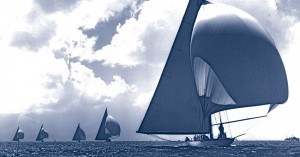

HANDLING THE J CLASS YACHTS IN THE 1930’s
The Skippers had to be experienced in racing and their skill on the race circuit became a matter of pride. These mighty craft had no engines and they had to be handled with great precision to get into and out of ports. Often their experience came from sailing all types of small craft, including fishing boats, during the winter months, when the J Class yachts were laid up. The permanent racing crew in the early days was probably around 16 men thou this may have been augmented to around 30 for racing. When not required for sail changes, spare crew were often moved to below decks.
With the incredible loads on the rigging and systems it was a constant concern that J Class masts could collapse in winds above a Force 3.
Sailing small boats in often inhospitable waters gave them the skills to manage their J Class yachts. The same is true today. Skippers have to deliver their yachts across Oceans, and compete around the race course, using their skills and all the technical advantages that are available today.
It is now clear that there was another J Class Yacht under development in 1937. Several years ago, drawings for a J-Class boat by Swedish naval architect Tore Holm were discovered by Fred Meyer, (Société Nautique de Genève – the Defender of the 32nd America’s Cup).
Now known as the Holm Project, this was to be a Swedish yacht with an innovative design. Many of the hull plates were made – and exist to this day. The project was put on hold prior to the outbreak of War in 1939 and was forgotten for more than 60 years. Endeavour and Endeavour II (K6) were laid up at Camper & Nicholson’s yard in Gosport, England.
Rainbow was scrapped. By the end of 1941, all the US yachts, which had been laid up were scrapped for their metal, with the last two being Yankee and Ranger. None survived. Yankee’s owner Gerard Lambert allegedly donated her scrap money from the yacht to Queen Mary to be used at her discretion in the London Hospital, in memory of the courtesies shown to Yankee by King George and the Queen herself.
Endeavour II was sold for scrap to Charles Kerridge Limited but her hulk remained until the late 1960s. Endeavour and Velsheda became houseboats in a mud berth on the River Hamble. This is where they stayed for more than 30 years, protected by the mud, which they had sunk into. Only Shamrock V was still sailing.
Endeavour II was broken up and scrapped in Southampton. Quadrifoglio (Shamrock V) had been hidden in Italy in a barn throughout the war years and following Crespi’s death in 1962 was sold to Piero Scanu, who saved her just two weeks before she was due to be broken up in Genoa.
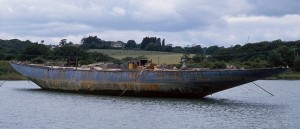
During the 1970s Endeavour’s hulk was sold for £10 and restoration was started.
Quadrifoglio (Shamrock V) arrived from Italy and was refitted at Camper & Nicholson’s yard where she had been built, supervised by Paolo Scanu the naval architect, and son of the owner.
The large holes in Endeavour’s hull were plugged and she was towed to the old seaplane base at Calshot Spit on the Solent to start restoration.
Terry Brabant rescued Velsheda from her Hamble mud berth and gave her enough of a refit to get her chartering and, occasionally, racing again in events like the annual Round the Island Race, hosted by the Island Sailing Club in Cowes. Despite being in rather poor condition she still acquitted herself well and looked magnificent from a distance. Swiss plans to restore her came to nought and the old racing yacht was eventually laid up afloat in Gosport. Elizabeth Meyer took on the challenge to continue with the rebuild of Endeavour at Calshot.
Quadrifoglio (Shamrock V) was purchased in 1986 by the Thomas Lipton Company, and given back her original name of Shamrock V, when she became the property of the Newport Museum of Yachting. Endeavour was towed from Calshot, to Cowes on the Isle of Wight to have her fittings and rigging fitted. She was then taken on a barge to the Royal Huisman Shipyard in Holland to continue and complete the rebuild.
Endeavour was relaunched in Holland. Endeavour and Shamrock V match raced each other over the Old America’s Cup course in Newport, Rhode Island in August.
Velsheda was purchased from a bankrupt C&N boatyard and brought to Southampton Yacht Services to start her rebuild. She was relaunched in 1998 and started her programme of racing and cruising around the World.
Velsheda, Shamrock V and Endeavour raced against each other in Antigua Classic Week.
The Owners met in England and formed the J Class Association to protect the interests of the Class, present and future. Class Rules were established for the construction of Replica Rebuilds from original plans. Shamrock V came out of a major refit at Pendennis in Falmouth under the supervision of the Dykstra office.

The first J Class Regatta is held in Christchurch Bay on England’s south coast over three days, followed by the Jubilee Regatta in Cowes.
Ranger replica was commissioned and construction started at Danish Yacht Shipyard.
Ranger was launched and started her racing programme.
Replicas of Endeavour II (Hanuman) and Ranger (Lionheart) are commissioned.
Replicas of Rainbow and Paine design (JH7) are commissioned.
Hanuman, replica of Endeavor II launched.
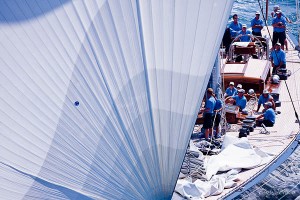
Lionheart launched.
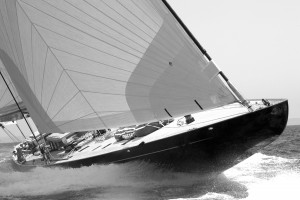
Rainbow launched. Cheveyo commissioned from Sparkman & Stephens / Spirit Yachts.

Information courtesy of the J Class Association
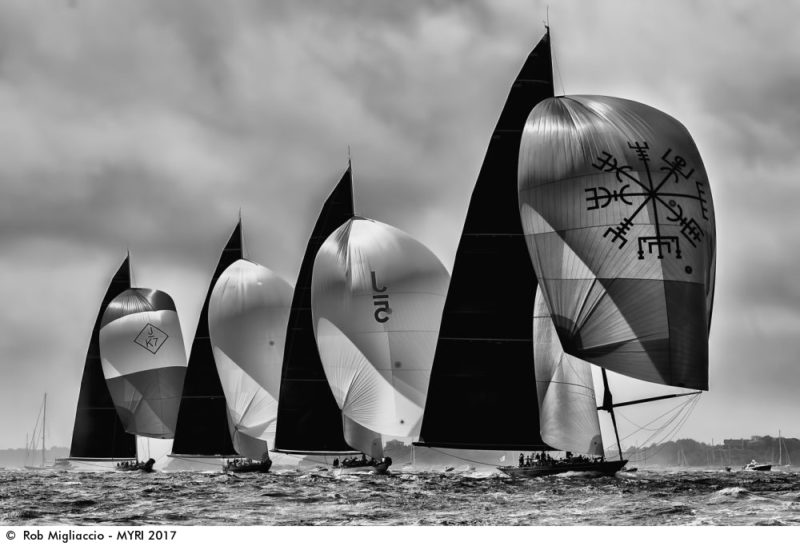
Svea, Velsheda and Topaz at the St Barths Bucket, 2018.
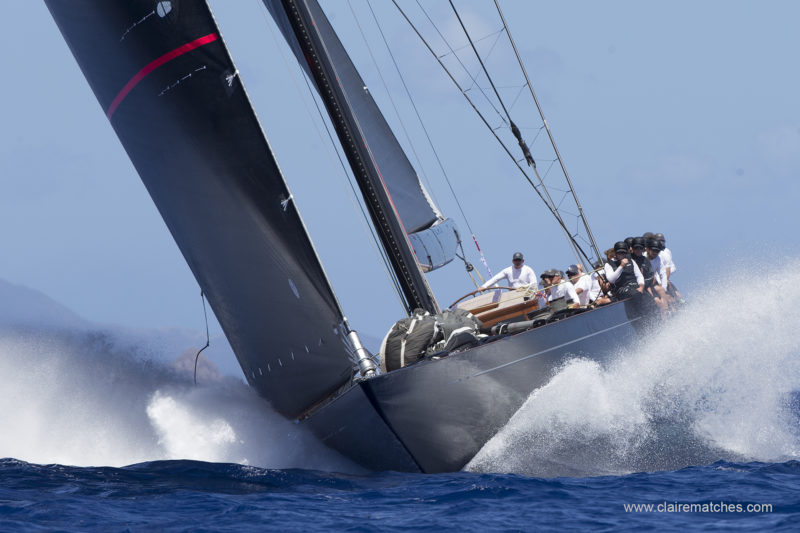
SHARE THIS:
- Yachts for Sale
Recently updated...
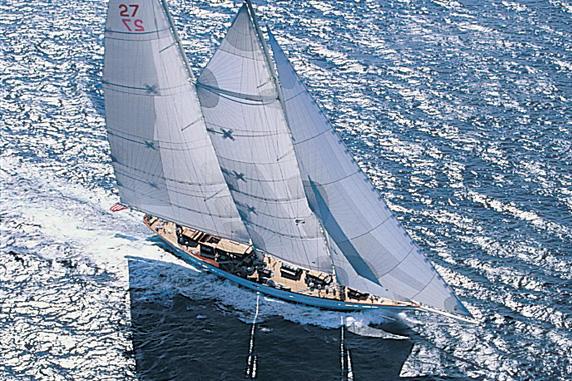
Write an Article
Covering news on classic yachting worldwide is a tall ask and with your input Classic Yacht Info can expose stories from your own back yard.
We are keen to hear about everything from local regattas and classic events to a local restoration or yachting adventure. Pictures are welcome and ideal for making the article more engaging.
With a site that has been created with the assistance of an international group of classic yacht enthusiasts we value your input and with your help we strive to make CYI more up-to-date and more informative than ever.
Please register and get in touch if you would like to contribute.

choose your language:
We’re passionate about Classic Yachts here at CYI, and we welcome submissions from all over the globe!
Captain, rigger, sail-maker or chef – if you’d like to write for CYI just let us know!
Email [email protected] to be set up as a Contributor, and share your Classic thoughts with the world.
ClassicYachtInfo.com has the largest database of classic yachts on the internet.
We’re continually working to keep it accurate and up-to-date, and we greatly appreciate contributions of any type. If you spot an error, or you have some information on a yacht and would like to contribute, please jump on in!
Don’t be shy…. Breeze on!
- Sell Your Yacht

- AMERICA'S CUP
- CLASSIFIEDS
- NEWSLETTERS
- SUBMIT NEWS
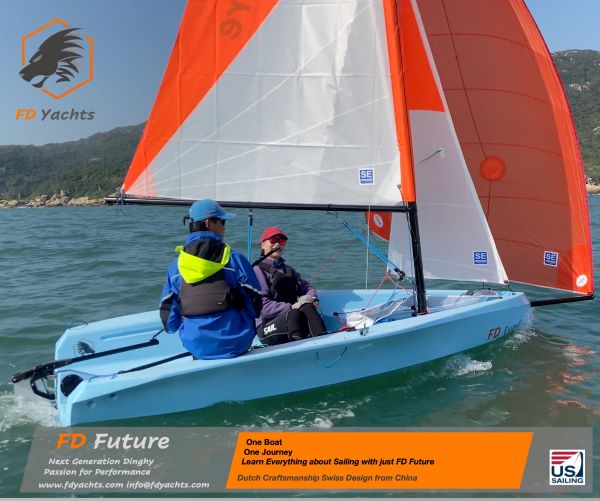
Seconds in it but J Class Svea completes title hat trick at Maxi Yacht Rolex Cup
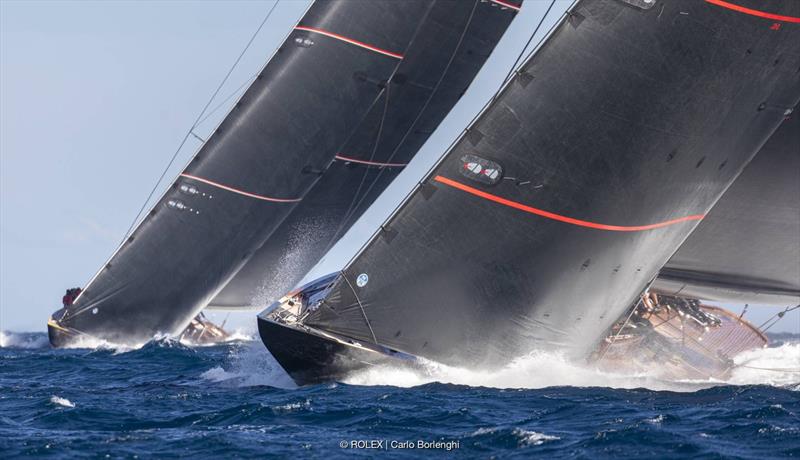
Related Articles
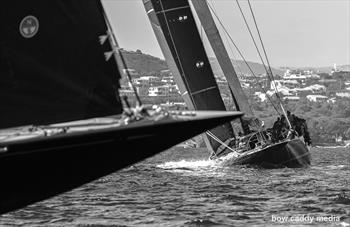

Published on March 9th, 2022 | by Editor
J Class Topaz: World’s coolest yachts
Published on March 9th, 2022 by Editor -->
Yachting World has been asking top sailors and marine industry gurus to choose the coolest and most innovative yachts of our times, and former world #1 match racer Pete Holmberg nominates J Class Topaz. Here’s the report :
“I’ve climbed a lot of mountains so choosing the coolest is a tough one, but it has to be the J Class Topaz. I love what we are able to do, to bring it back and sail to a high level, combining history with modern technology.
“Figuring out how to manoeuvre this thing properly, accurately, and do it right, is the ultimate challenge. But we put it right in there; when we’re racing, we’re metres apart in these big things.”
Holmberg is the racing helmsman on Topaz, J8, one of the most recent of the J Class yachts. She was built to a Frank Paine design from 1935, optimised by Hoek Design, and launched in 2015. Under Holmberg and her race crew, performance and results have steadily been improving. She won over Velsheda at the Superyacht Cup in June.

Holmberg says the addictive thing about the Js is that they are a challenge to handle, being slow to respond and with a race crew of over 30, and they will punish any mistake.
J Class Topaz Stats rating: Top speed: 12 knots LOA: 42.7m Launched: 2015 Berths: 15 Price: $20-30m Adrenalin factor: 80%
For Yachting World’s list of cool boats, click here .

Tags: coolest yachts , J Class , Peter Holmberg , Topaz , Yachting World
Related Posts
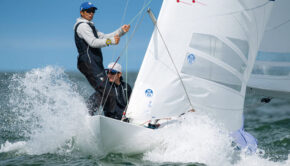
How to build a great sailing crew →
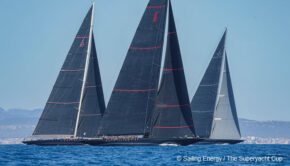
History returns to the America’s Cup →
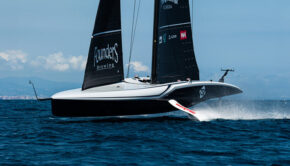
Will USA’s radical design choices pay off? →
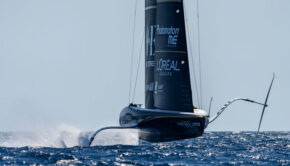
Who is the quickest America’s Cup team? →
© 2024 Scuttlebutt Sailing News. Inbox Communications, Inc. All Rights Reserved. made by VSSL Agency .
- Privacy Statement
- Advertise With Us
Get Your Sailing News Fix!
Your download by email.
- Your Name...
- Your Email... *
- Name This field is for validation purposes and should be left unchanged.


The global authority in superyachting
- NEWSLETTERS
- Yachts Home
- The Superyacht Directory
- Yacht Reports
- Brokerage News
- The largest yachts in the world
- The Register
- Yacht Advice
- Yacht Design
- 12m to 24m yachts
- Monaco Yacht Show
- Builder Directory
- Designer Directory
- Interior Design Directory
- Naval Architect Directory
- Yachts for sale home
- Motor yachts
- Sailing yachts
- Explorer yachts
- Classic yachts
- Sale Broker Directory
- Charter Home
- Yachts for Charter
- Charter Destinations
- Charter Broker Directory
- Destinations Home
- Mediterranean
- South Pacific
- Rest of the World
- Boat Life Home
- Owners' Experiences
- Conservation and Philanthropy
- Interiors Suppliers
- Owners' Club
- Captains' Club
- BOAT Showcase
- Boat Presents
- Events Home
- World Superyacht Awards
- Superyacht Design Festival
- Design and Innovation Awards
- Young Designer of the Year Award
- Artistry and Craft Awards
- Explorer Yachts Summit
- Ocean Talks
- The Ocean Awards
- BOAT Connect
- Between the bays
- Golf Invitational
- BOATPro Home
- Superyacht Insight
- Global Order Book
- Premium Content
- Product Features
- Testimonials
- Pricing Plan
- Tenders & Equipment

The Rise of the J Class Sailing Yacht
J Class yachts drew gasps of admiration in their 1930s heyday. Eighty years on, they still do .
Nearly 20 years ago, I remember crunching along the shingle to Hurst Castle, jutting far out into the Western Solent, for a glimpse of three huge sailing boats as they fought the ebb tide. It was 2001, the 150th anniversary of the America’s Cup , and the three yachts were Endeavour , Shamrock V and Velsheda – the last of the original J Class. I stood with hundreds of others transfixed as the boats hammered past into the Solent on their way home to Cowes.
Built to contest the America’s Cups of the 1930s, these Js were designed by legends such as Charles Nicholson , Starling Burgess and Olin Stephens . Their names were bywords for romance and luxury; their owners celebrities.
But such is their capacity to entrance, these 36-metre to 43-metre sloops, with their giddy overhangs fore and aft, have actually grown in number since 2001. Today the fleet numbers nine yachts, with a further two on the drawing board. And, if you’d been lucky enough to be in Bermuda in mid-June 2017, you would have seen seven of these magnificent boats vying in the America’s Cup J Class Regatta. “The class has grown because of its incredible history of racing and the America’s Cup – and the sheer beauty of the boats,” Velsheda’s owner Ronald de Waal says. “Sailing on one is an incredible experience and the racing is equally exciting.”
And yet despite its resurgence, the J Class story owes as much to mud berths and rusting hulls as it does to regattas and billionaires. The US fleet was scrapped for materials after the outbreak of the Second World War, but three heavily built British Js survived. As America’s Cup challengers, they had to cross the Atlantic Ocean on their own bottoms to take part. Velsheda spent entire decades holed up on the Hamble, Endeavour was rescued from the scrapyard, while the wooden-hulled Shamrock V was cruised in the Med.
The tide turned fair again for the J Class only as recently as 1984, when American sailor Elizabeth Meyer bought the hulk of Endeavour and set about restoring her. “Elizabeth is very much the catalyst for the revival of the J Class with the renovation of Endeavour in 1984,” Philip Lotz, commodore of the New York Yacht Club, said in 2017. “Her vision and inspiration… got restoration going not only for the J Class but for all classic yachts.”
Meyer was nearly overwhelmed by the task; it took just two years to make Endeavour seaworthy enough for towing to the Royal Huisman yard in the Netherlands. She famously said that 98 per cent of her net worth was tied up in Endeavour by the time she sailed again in 1989.
Meyer was also the person responsible for refitting Shamrock V in 1989 and that summer, the first J racing of the modern era captivated spectators from Maine to Maryland. At first it was an amateur affair, with crews recruited by skipper Gary Jobson. “We sent forms out to 200 sailors he knew and we ended up with 600 replies,” Meyer recalls. “Sailors were Xeroxing copies and sending them back to us. I told Gary, ‘Well, we will just have to run a lot of regattas.’”
The admiration that had made the J Class and their owners front-page news in the 1930s was as strong as ever. “The J Class boats seemed to be worshipped everywhere,” Meyer says, “venerated like a mix of what might be expected for a film star or something like the Eiffel Tower.”
Velsheda was next in line for a refit and the three Js raced side-by-side for the first time at Antigua Classic Week in 1998. By now the late John Williams, an American property developer, had initiated work to build a replica of the Sparkman & Stephens-designed “super-J” Ranger . Harold Vanderbilt’s original had all but dismissed the challenge posed by Sir Thomas Sopwith’s Endeavour II in the 1937 America’s Cup, and was considered among the fastest Js.
With new boats being built, ground rules were urgently needed to keep the racing fair, and so in 2000 the J Class Association was born. Its first and most important rule was to restrict new J Class yachts to existing lines plans from the 1930s – something that instantly limited their number to 22 hulls. “Not all of the original lines are interesting,” says Andre Hoek, the noted naval architect who was involved in updating the designs for the build of Lionheart , Topaz and Svea . “There are nine boats in the water, and probably only five or six more of interest.”
Then performance limits were determined to prevent extreme design. “You have to maintain the original freeboard and the rig geometry,” Jeroen de Vos, naval architect at Dykstra, explains. “And new boats have to have a functioning interior. You don’t want a situation where the old boats become obsolete.”
The only major concession has been to allow lighter hulls built from modern aluminium and other materials, instead of the original Tobin bronze or steel and timber, and the rudder shape can be modified. But most of the magic happens from the deck upwards. All the boats sport top-of-the-line carbon sails, carbon spars and hydraulics that can put up to 35 tonnes of tension into the headstay. It’s a huge contrast to the 1930s, when the 50-metre masts were prone to tumbling over the side in anything more than a force 3, so stretchy was the rigging of the day.
Regular refits keep today’s Js at the leading edge of new technology. “We have the chance to play with all of it, and the level of the other teams constantly pushes us to do more,” says Velsheda skipper Barney Henshaw Depledge.
In 2016, Southern Spars shaved an impressive 800kg off Hanuman’s rig weight by using super-thin carbon laminate and ECsix rigging. That’s the equivalent of removing 10 crew members sitting on the second spreaders. “The mast specifications nowadays are expected to be in the same ballpark as the most modern race yachts,” says Steve Wilson, senior designer and co-founder of Southern Spars.
Just as important is a clean deck plan that favours communication between the 30-plus racing crew and facilitates sail changes. “Deck layout is a huge part of it for being able to pull down headsails of 450 square metres and kites of 1,000 square metres,” de Vos adds.
Using an algorithm to predict performance, each hull is rated accordingly – but with only minute differences separating them, the Js are more akin to a one-design fleet. “The racing is very close – it’s won on seconds,” says de Vos. “Because the boats are so close, if you cross the line ahead, you’ve basically won.” This draws some of the world’s top sailors, from Volvo Ocean Race veteran Bouwe Bekking (tactician on Lionheart ) to two-time America’s Cup helmsman Ken Read (Hanuman and Topaz ) and a host of young talent.
Off the racecourse, the Js have a different appeal, with lavish panelled cabins, marble-lined bathrooms and cosy deckhouses. “The boats are quite deep in the water and therefore are very comfortable below,” de Waal says of his beloved Velsheda . “There is a lot of deck space as well. You can enjoy very relaxing and quiet moments of cruising with your family and friends.” Some of the boats charter, too, with prices starting from $65,000 (£50,000) per week.
Perhaps the last word about the J Class should go to its modern-day saviour, Elizabeth Meyer. “We love them because they are sublimely beautiful, utterly impractical and fiendishly demanding.” And that, in a nutshell, is it.
Sign up to BOAT Briefing email
Latest news, brokerage headlines and yacht exclusives, every weekday
By signing up for BOAT newsletters, you agree to our Terms of Use and our Privacy Policy .
More about this yacht
More stories, most popular, from our partners, sponsored listings.
- Share full article
Advertisement
Supported by
At the Maxi Yacht Rolex Cup, J-Class Yachts Are Back
These majestic boats, which were abandoned before World War II, are on the water again, built using old designs.

By Kimball Livingston
Falling off the deck of a giant J-Class yacht is not an everyday thing, but there is risk enough that each J in competition has a chase boat to rescue sailors who do fall. Imagine manhandling enormous sails on a narrow, slanting, pitching deck without the protective fencing of the lifelines that are standard on other boats.
There are no lifelines on J-Class boats because they would interfere with tacking the enormous forward sails, the jibs. And then there’s a century of tradition: Those lines would compromise the boat’s classic looks.
Around 50 boats are competing in the Maxi Yacht Rolex Cup starting on Monday in Porto Cervo, Sardinia, including four J-Class yachts. While many of the boats will be 60- to 80-feet long, Js are well over 100 feet, with masts much taller than that. They tower majestically over other boats.
“The Js have the most graceful shape imaginable, and in their sheer scale they project a sense of grandeur that no other boats can match,” said John Kostecki, an Olympic medalist and America’s Cup winner. “The first time you see them on the water, they take your breath away.”
J-Class yachts had their own era in America’s Cup history. They were built from specifications laid down at the turn of the last century and chosen three times for America’s Cup matches between the United States and Britain from 1930 to 1937.
The original Js were extravagant throwaways, intended only for racing. Not one was kept in sailing trim through World War II. What wasn’t salvaged for war materials was simply abandoned. Original J-Class yachts were never intended for casual weekend sailing, and they had outlived their purpose for competition.
J-Class designs have since been resurrected by a few owners who can afford to indulge themselves in their beauty and romance. There are now seven in the world.
One competing in Sardinia is Velsheda, which was built in 1933 and abandoned in the mud in 1937. It was rescued in 1984 and now is owned and helmed by the Dutch businessman Ronald de Waal. It looks 1933-fresh after an extensive renovation.
The other Js racing on Monday are replicas of boats long discarded or designed but never built, and now constructed to modern standards and with modern features, like the 135-foot Ranger. Harold Vanderbilt defended the America’s Cup on the original Ranger in 1937.
The replica Ranger will be helmed by the 2007 America’s Cup winner Ed Baird, with Kostecki as the tactician.
Svea and Topaz are also replicas. Svea had been designed but not built in 1937, intended for a Swedish America’s Cup challenge that was canceled because of the war. It was launched in 2017, and its primary winches — for controlling the enormous sails — are customized for different maneuvers at different, hydraulically powered, computer-controlled rates of speed.
At 143 feet long with 176 feet of carbon mast, Svea is the longest and newest J.
Topaz, a 1935 design, was built in 2015 and will by helmed in Sardinia by Peter Holmberg, an Olympic medalist and America’s Cup winner.
In building replicas, there is no forgiveness in design below the water. However, compromises are allowed elsewhere. One such compromise is the gleaming house that rides above the deck on Ranger. Vanderbilt’s Ranger had no house for lounging in the shade, but the new house is a comfort spot for the owner and guests when the boat is not racing. During regattas, Kostecki said the structure was a visual obstacle for Baird.
Different lengths and weights also produce differences in performance. New boats are faster than old boats, in part because of the ability of modern materials and engineering to carry more tension on the forestay — linking the top of the mast to the front of the boat — to prevent sagging of the sails.
Tom Dodson of New Zealand, a sailmaker and tactician on Velsheda, said: “The new boats might carry 36 tons of load on the forestay. Velsheda at age 89 can handle at most 22 tons before the boat starts to twist and flex, but that’s still a lot of cars hanging off your mast.”
A time correction formula used in regattas allows boats launched decades apart to compete fairly.
“Some factors can be calculated and others can’t, but the boats are so big and so heavy that they push through the water at close to the same speed. The latest correction system seems to be working. Velsheda wins races. Topaz and Svea both won races in July at Palma,” Dodson said, referring to the Superyacht Cup in Spain.
Helming these boats is not stress free. Given their tonnage and outdated configuration, the long keel in particular, Js do not turn on a dime.
“These are far and away the hardest of all boats to steer accurately,” Dodson said. “When I have to step in [at the helm], maybe while Ron wipes his sunglasses, my heart rate shoots up. Along with responsibility for the safety of all, at the end of the day, if it’s a job well done that’s a lot of satisfaction — respect due.”
Francesco de Angelis has skippered in the America’s Cup for Italy and has sailed on many of the J-Class yachts now in commission.
“I began with Endeavour, the first of the three original Js to be restored,” he said. “I was curious because the class was such a milestone in yachting.”
As tactician now for Topaz, de Angelis said, “Because the boats are not highly maneuverable, gauging time and distance to the starting line requires you to commit to your approach with three minutes left in the countdown to the start.
“On the course, you can’t afford to make many maneuvers, so you have to choose well and execute well.” Once committed to a tack, “there’s no turning back.”
The 2022 season represents a strong foundation for the J Class future
.jpg)
November 1, 2022
Image credit:
The 2022 season has seen the J Class gather considerable momentum. After five years marked by limited and sporadic racing at mixed fleet regattas, this season followed a consolidated, popular programme of class racing at three great events in the Caribbean and Europe. In many senses this season has been the perfect first steps on the course to 2024 when a very strong fleet of J Class yachts look set to muster in Barcelona to take centre stage at J Class World Championship during the 37 th America's Cup period.
New owners breathed new life into two J Class campaigns and were rewarded with regatta wins on their respective debuts. As class racing returned to the Saint Barth's Bucket in March where three boats enjoyed classic Caribbean trade winds conditions, Ranger, took the top award ahead of Hanuman and Velsheda.
For the new, younger generation owner of Ranger, for whom their first ever racing sailboat is the 2003 built J Class, a debut win might have been unexpected. It was, however, a well-earned result for a team which is full of talent, with offshore and ocean racing experience fired by great enthusiasm with America's Cup winners Ed Baird on the helm and John Kostecki as tactician.
The theme of debutant winners continued in June at the Superyacht Cup Palma where the J Class returned in numbers for the first time since 2014. During last winter a trio of well-known Swedish entrepreneurs - who are all accomplished and passionate sailors - acquired the Swedish designed Svea from the USA, looking to enjoy racing with the class under the Swedish flag for the first time.
Under J Class world champion tactician and round the world racing ace Bouwe Bekking, a Svea team comprising a mix of experienced offshore racers as well as young, inshore 40-footer racers - most of whom had never been on board a J Class yacht quickly transformed into a regatta winning outfit. In mainly light winds on the Bay of Palma, all the competing J Class teams Svea, Topaz, Ranger and Velsheda - won races, but the Swedish flagged crew prevailed.
All four J Class teams, Svea, Topaz, Ranger and Velsheda sought to raise their game and peak at September's weeklong Maxi Yacht Rolex Cup, widely known as the 'maxi worlds'. The annual Porto Cervo, Sardinia showcase saw a glittering, diverse turnout of top maxis and crews and all were delighted to see the J Class back racing as a group, with their own starts, on the beautiful Costa Smeralda waters. There was a good mix of light to fresh conditions over the course of the event, the highlights, as ever, being close, boat on boat racing in the La Maddalena archipelago and up and down 'bomb alley'.
With one of the owners steering, Svea proved a cut above. They won four races from the five starts, Velsheda winning the other, to clinch their second major regatta title of the season and lay down a marker for the 2023 season and beyond.
In Porto Cervo one of Svea's owners a past Maxi World Championship winner - enthused, "The word is majestic. These boats are 180 tons, and it is tight racing. It is so different. You need to get used to the anticipation and a few more turns on the wheel, you really have to work hard. We did not have expectations, this year was a learning curve, we just wanted to learn to sail the boat and so here we have overachieved."
Svea also won the Royal Northern & Clyde Yacht Club Corinthian Cup for the top owner-driver in the J Class at the Maxi Yacht Rolex Cup.
By taking second place in Porto Cervo and winning the Saint Barth's Bucket Ranger lift the 2022 season title, the Kohler Cup, topping off an auspicious debut. The delighted Ranger owner remarked "It is an amazing accomplishment for a boat which I don't think people expected to do so well. It is really gratifying. And that is entirely down to the team."
The season of class racing was contested under the latest version of the updated J Class rule which has reached a proven level of reliability, in no small part because of the comprehensive number of races sailed and the volume of data processed and analysed by J Class Technical Director Chris Todter, who has worked hard to refine the rule to take account as many of the speed and stability inducing factors as possible.
Appointed in April, J Class Secretary Stuart Childerley quickly appraised the position of the class and got to know the owners and teams and their respective objectives for the short, medium and long term. He has taken on the initiative to develop a sustainable, long-term programme of events, taking account of the downturn after a peak at the 2017 J Class World Championships in Newport USA.
Childerley, an international race officer, two times Olympian, (Volvo) Ocean Race sailor and international keelboat champion, is positive about the future of the class, which is set to see more boats racing in 2023 and beyond. "We are pleased to know Rainbow is starting an extensive refit in Palma, likely ready to race in late summer 2023, while Svea is planning to continue cruising and racing in 2023. Lionheart and Velsheda have recently commenced deck replacement projects and hope to sail in June 2023. Hanuman is expected to continue cruising on the NE coast of the USA. Endeavour, based in Palma, is sailed regularly, Shamrock continues her refurbishment programme in the UK and owner Hugh Morrison is looking forward to racing her in 2024. "
Rainbow has been bought by passionate New Zealand racer Neville Crichton, and boat captain Matthew Sweetman reports, "We aim to have the boat out of the water at the end of November and do a full refit to bring her up to 2023 J Class racing standards. That will involve new teak decks, new paint, some work on the hydraulics. We aim to be on the water next year and we will see how we go before brining some new sails online. We want to do some training with some of the other boats before we go racing."
Sweetman expects Rainbow to be back in the water in July next year and reports that Erle Williams, who has a strong J Class track record previously on the helm of Ranger, will play a key role.
"We are looking forwards to getting the boat back racing, it is what they were designed to do. Everyone tells us Rainbow is a quick boat, but we will see. She has not really raced since Porto Cervo 2014 and we are eight, soon to be nine years down the line. Things have changed dramatically with the class since then, so we will see how we go when we are back in the water next year to see what else we need to do. We have a decent understanding of the class. Everyone is doing the same to make the boats faster and we need to see. With the America's Cup in Barcelona and Neville Crichton being a proud New Zealander, he wants to be there in a good position to compete at the front end of the fleet and Neville wants to fly the New Zealand flag."
The J Class programme for 2023 looks set to focus on the Maxi Yacht Rolex Cup, September 2023, and the Ibiza JoySail regatta, 28 September 1 October.

This site uses cookies to enhance your experience. By continuing to browse the site, you consent to the use of cookies. View our Privacy Policy for more information.
Yachting World
- Digital Edition

Inside J Class yacht Svea – what it’s really like to race on board the newest member of the fleet
- Toby Hodges
- June 16, 2017
Toby Hodges sails the newest J Class yacht, Svea, and finds an elegant J crossed with a modern maxi grand prix yacht. Photos by Carlo Borlenghi
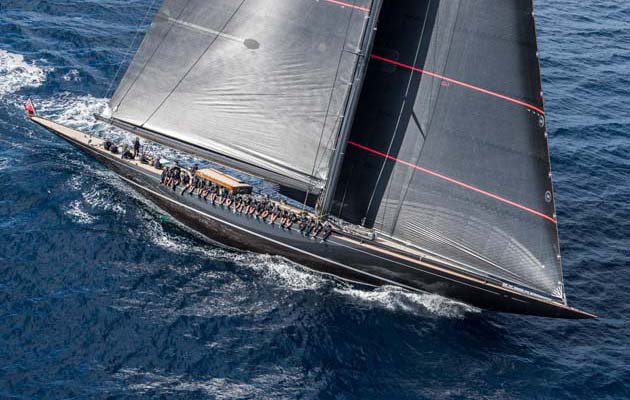
Svea , the newest addition to the now nine-strong J Class fleet, is one of the most outstanding new yachts of modern times – a harmonious meeting of historic and modern design; a blend of J Class lines and maxi grand prix yacht technology.
What follows will hopefully explain why she is the ultimate modern J; why her design and engineering had to be fast-tracked yet still produced such formidable results, and, crucially, why the other six Js and their 200 professional crewmembers racing in Bermuda this June were right to be worried about their new competition.
Svea ’s build programme has been unrelenting since her American owner bought the bare aluminium hull two years ago. A serial yacht owner and experienced racer, his sights were firmly set on the J Class regatta in Bermuda.
This is the biggest year for the J Class since they raced for the America’s Cup in the 1930s .
The first time six Js raced together was in St Barth in March , but when Svea joins the fleet in Bermuda, it will be the first time seven have lined up. But for that to happen Svea had to take shape fast.
It was just 17 months from signing the contract to her delivery – a race-ready superyacht prepared to sail across the Atlantic to her first race, just as the original Js were designed to do.
Svea arrived in Palma in March to start sea trials and race training. I was invited aboard in late April for what turned out to be the last day of race training – and a day I shall never forget.
1930s lines, modern layout
All Js dazzle on the water, but Svea simply stops you in your tracks. Her lines and deck are kept spectacularly clean, thanks to the compact wheelhouse, sunken wheel and wonderfully low boom.
Her dark metallic grey hull and black and red sail wardrobe lend her timeless lines a slightly menacing appearance – a purposeful racing look that belies the luxurious interior below decks. The aggressive aesthetics are in keeping with her name, a Viking word (it means Swede).

The lines for Svea are from a Tore Holm design from 1937, the last J drawn but one that was never built. Holm was one of the most gifted Metre Class designers.
Andre Hoek reworked the design to make it competitive for modern day racing. This is his third J project in recent years following Lionheart and Topaz .
Continues below…
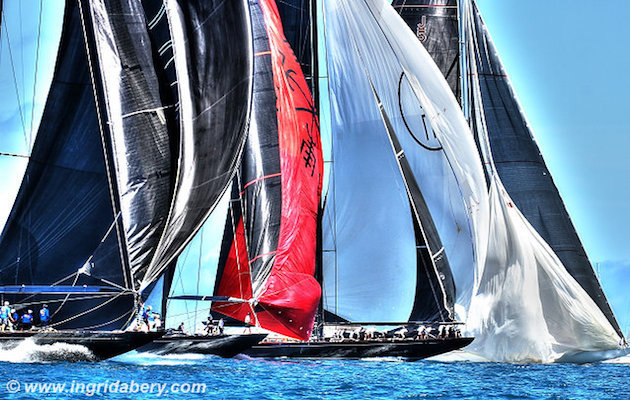
Brand new J S1 Svea stars in a record J Class racing fleet at America’s Cup
We expected her to be fast, but would the new J Class Svea be competitive too? It is a tall…

Svea rules the day and Lionheart wins the J Class Superyacht Regatta in Bermuda
If Svea’s third place in her first race yesterday was impressive for the debutante J Class member, her victory over…
Even compared to these ‘Super Js’, Svea is big. She is, by 15cm, the longest J overall at 43.6m /143.1ft LOA.
Think of classic J Class pictures from the 1930s and you picture a helmsman in a blazer and tie standing high on the aft deck battling a traditional wooden wheel. One of Svea ’s striking features is her extra large wheel, nearly half of which vanishes into a well below decks.
Hoek encouraged the extra wide, sunken wheel, a feature that Frers favoured in the 1980s because it allowed the helmsman to sit out and see the telltales. Here it allows the helmsman, trimmers and afterguard to remain in close communication.
Svea ’s deck layout is optimised for modern racing thanks to a large cockpit directly in front of the wheel from which the main, genoa and running backstays are all controlled. This means crew dealing with the runners and their fearsome loads are not on the aft deck and can safely operate the winches from a standing position.
The cockpit also doubles as a guest area when the yacht is in cruise mode, and there is removable seating and table.
I observed the action from the aft deck, in the company of Andre Hoek and the owner’s representatives and project managers Tako van Ineveld and Katie Beringer from Ineveld & Co. With its long overhangs a J’s ends are prone to pitching and as they are raced with no guardrails you need to be vigilant when the yacht is heeling.
Maxi grand-prix set-up with walnut interior
“Be careful on deck – we’re running big loads – up to 36 tonnes on the forestay,” Svea ’s captain Paul ‘PK’ Kelly told us as we left Palma’s STP shipyard. That’s the weight of a 60ft cruising yacht, I thought!
“It’s a maxi grand prix set-up in every detail,” said Tako van Ineveld. “We will race it as a grand prix boat. The owner loves that, but he also loves his walnut interior.”
And that, I thought, in a nutshell, is what today’s J Class yacht is all about.

When I joined, the 24-strong race crew and six permanent crewmembers had been practising multiple pre-starts and two or three windward-leeward races a day. Granted, they had no competition, but I soon appreciated how getting the timing for the manoeuvres down and, crucially, knowing exactly how long each will take, is invaluable preparation.
As in a regatta, it takes a couple of hours between the time a J leaves the dock to the point at which it is fully prepared for the start. But when we were, and fully heeled over in full trim, sailing at 9.5 knots upwind in 9-9.5 TWS, the feeling was euphoric.
Svea ’s immense black North 3Di RAW mainsail was allowed a little body to match the lighter conditions that morning. The sails are obviously big business on Js and Tom Whidden, North Sails’s CEO, was aboard for the day assisting the afterguard.
Furling headsails are a new addition this year for some of the newer Js. A crewmember needs to go aloft to attach the lashing to the head during the hoist, so it takes longer to swap headsails, but the advantage is a marked improvement in sail handling time.
The decision was taken early during Svea ’s build to incorporate furling headsails, for which a Reckmann torque tube is installed on deck. “It’s a big help not having to drag headsails out of the water,” van Ineveld remarked.
A glance aloft shows a particularly aggressive Southern Spars rig design. Every bit of weight and windage was minimised, with no staysail halyard and only a single VHF aerial permitted from the mast top for example.
The Southern Spars boom is tapered at each end and the spinnaker pole is a novel triangular shape – which is promised to be lighter than an equivalent tube, if more vulnerable to impact.
During a couple of the upwind legs I sat forward of the wheelhouse, watching the choreography of the pit and foredeck. While the main and trimmers may be in better contact with the afterguard in their aft cockpit setup, it’s still a separate camp up here.
The wide, shallow pit serves a useful area to tidy the vast amount of tail ends for spinnaker sheets, inhaulers, barbers, etc and for storing sails or snaking the spinnaker when zipping it up.
When the wind died down to 8 knots there was talk of whether to lead the sheets for inside gybing on the downwind leg. It’s amazing to think that a 950sq m kite can be gybed inside these days, but it’s a call that needs to be made relatively early as it involves changing the tack strop and sheet leads.
It’s almost impossible to take in the flurry of activity that two thirds of the crew are involved with around the mast and foredeck during a hoist – that was governed by Team New Zealand veteran sailor Andrew ‘Meat’ Taylor, a crew boss whose physical presence immediately ensures respect.
The spectacular bright red kite went fizzing up and ballooned into life, filling out a symbol depicting an ancient Nordic compass rose.
When the wind increased to 12 knots for the second practice race that afternoon, everything felt a little more intense on board. The headstay load pin readout was up to 30 tonnes. There was more water coming over the deck, the stiff carbon sails snapped into place with a bang, when the runner was eased, the blocks sounded like a shotgun going off, shuddering a vibration through the aluminium deck.
We were making up to 10.2 knots upwind now. Francesco de Angelis, the ex- Luna Rossa skipper hired as owner’s coach, calmly steered sitting to windward, alongside the likes of Peter Isler navigating and the owner’s long-standing tactician and fleet manager Charlie Ogletree (an Olympic Tornado sailor).
We crossed the line within a second of the gun and Svea stepped out into her full graceful stride on another long leg.
As we rounded the top mark into the short reaching leg a late call is made for an ‘Indian’ – or gybe-set. It’s a test designed to time the crew response.
We gybed and the kite was hoisted in little more than a boatlength – I counted five seconds. There is a nod of approval from Tom Whidden, who comments: “That’ll allow you to go either way round the top mark – a pretty nice exit manoeuvre to have, especially if you’re in a train.”
I was astonished at the speed of the gybes. The boom is sheeted to two winches, both capable of spitting line out at 220m per minute. So even with the boom fully out when sailing downwind, it is centred in a couple of seconds.
The speed of the manoeuvres, especially after only three weeks’ training, was seriously impressive. I later learned that this was their best training day. Even so, it was remarkably quiet and well drilled.
Van Ineveld told me the crew was very pleased with how reliable all the systems have been, especially the hydraulics. He pointed out that Js have habitually suffered from hydraulic power failure, which is why they put the Power Take Off (PTO) on the main engine. “So far we’ve had no lack of hydraulic power and we’re only running at 70 per cent”.
The hydraulic pressure for Js is normally 220bar, but Svea has larger diameter pipes allowing more flow at 300bar. “ Svea comes out of the box where others want to be,” says van Ineveld. “It’s where all the recent work to Lionheart and Hanuman has led – it’s the advantage of starting from scratch.”
Sailing Svea – the newest member of a revered class
During our final upwind leg, something happened that has changed my appreciation of sailing a J forever. Ogletree beckoned me to the wheel, mocking de Angelis by telling the elite helmsman: “You’re fired.”
My heart rate rocketed. I told myself to focus – I would only get a few taster seconds of the owner’s experience on the wheel. Sailing a J in race mode with race crew? More people have been to the moon.
But that ‘time’s up’ pat on the shoulder never came. The gargantuan wheel was entrusted to me for the rest of the upwind leg, the mark roundings, the spinnaker hoist and the downwind gybes all the way to the finish.

Focus, Toby! I asked de Angelis what sort of numbers we should be doing. “Just sail it to the telltales” was his refreshing answer – although in fact the genoa is professionally trimmed before I could even correct the wheel. The subsequent “9.8 knots target speed at 45º…” certainly helped.
Standing to leeward I was struck by the force of the wind slot between the sails and how hard it becomes to hear anything. As we tacked I bent for support to hand-over-hand the 8ft diameter carbon and teak wheel. Svea was back up to full speed. “You got the mark?” Ogletree asked. I nodded. “Over to you.”
Panic. Keep calm and don’t hit the buoy. I was aware of a flurry of activity on a foredeck far, far away. It helped make me appreciate just how focused the crew have to be on their role during a race. You have to be able to trust that everyone’s on it – I found it almost impossible to concentrate on anything other than pointing the boat from behind the wheel.
Turn the wheel and it’s still some moments (and distance) before the boat responds. It shows the value of anticipation.
We powered through a reach and bore away into a spinnaker set, at which point I went into a giddy trance, trying to mentally distill the moment while gybing Svea downwind. To drive the latest, most high-tech yacht in the most revered class in the world, with a full complement of rock stars and one of the world’s foremost sailors alongside coaching me through it… no, superlatives will never suffice.
“Well done everyone, that was a great day today,” said Ogletree in the debrief back on the dock, as my pulse began to settle. “The best we’ve sailed the boat and the best it’s gone.”
No room for delay
Svea ’s deck is kept wonderfully clean. The original lines didn’t even have a deckhouse, something the class insisted upon, says Hoek, but Svea ’s is kept low.
The furler and tensioner for the inner forestay are hidden under the deck. The anchor arm (removed for racing) rotates out of a locker and extends over the port bows. The chainplates with integrated turnbuckles are underdeck leaving just the ECsix rigging exposed.
It was eye-opening to see just how well Svea is finished below, particularly after visiting her in build at Vitters in December – at which time no cabin had yet been completed. Austrian company List pre-fabricated the interior entirely off site – a feat of 3D modelling and engineering.
The late Pieter Beeldsnijder (who worked on Athena , Hyperion , Hanuman , and Ethereal ) designed an elegant interior that is timelessly finished by Michiel de Vos.
Raised and fielded panels are used together with both decorative and practical features such as curved handrails built into panels. These reflect the owner’s taste for millwork carpentry. His preference for an open grain to the Claro walnut helped produce a tactile finish.
The intricate design details and the complex build skills required are particularly impressive when you consider the time frame in which Svea was completed. Normally an interior is built in parallel with the hull, but in this case it was built and fitted during the 14-month Vitters yard period.
“There was no room for delays with the race programme for Bermuda,” said Tako van Ineveld.
A traditional skylight floods the saloon in natural light. A sliding hatch in the bulkhead between the saloon and the galley further forward helps open out this space and allows the owner to incorporate the compact galley into his living space. It’s a clever arrangement that also keeps the teak-finished crew area forward private.
The layout elsewhere is traditional for a J, with guest en-suite cabins (twin and double) each side of the companionway and the master stateroom aft. The saloon and cabins lacked a personal touch during our visit – the bulkheads were still bare – however 16 marquetry pieces inspired by classic Beken pictures were imminently due to be hung.
Beeldsnijder succeeded in pushing accommodation space to the maximum inside. This is evident in the aft cabin, where the longitudinal frames rise up towards the transom through the berth and sofas. The low wheelhouse squeezes the accommodation in the passageway aft, but this has been cleverly sculpted out at shoulder height.
The engine room, accessed from the passageway opposite the compact navstation or via the saloon sole, is particularly well laid out offering easy access to all the systems.

One to watch
The flurry of new Js and competitive regattas in the last decade has brought with it a chase to upgrade to the latest equipment. This is particularly the case with Hanuman and Lionheart . Svea , however, is today’s true answer to a race-ready J class.
“What an accomplishment it will be to make the start line at Bermuda, a year after going into Vitters,” said captain Paul Kelly. When I left, I was bowled over by this yacht, build and crew work and results so far have been very encouraging .
I am also now that bit closer to understanding the charms of the mercurial J from an owner’s point of view. To buy and helm a J Class yacht in a competitive race is the ultimate money-can-buy experience in sailing – and, arguably, in any sport.

IMAGES
VIDEO
COMMENTS
Learn about the history, design and performance of the J Class yachts, the world's most elegant racing fleet. Endeavour is one of the original six J Class yachts, launched in 1934 and refitted in ...
J Class yachts are large sailboats built to the Universal Rule, which rates their speed and size based on length, sail area and displacement. They were used for the America's Cup from 1930 to 1937 and have been revived by modern classics and new builds.
Learn about the J Class yachts, the iconic 130ft racing-cruising sailboats that have undergone a revival in the last decade. Discover their origins, design, features, events and owners in this ...
Known as Project J8 while in build, the 42.62 metre J Class yacht Topaz was launched from HJB's shipyard in Zaandam, The Netherlands. HJB has launched J8, now named Topaz. Designed inside and out by Andre Hoek, Topaz 's hull design features a reduced wetted surface and higher keel aspect ratio to the longest waterline found on J Class yacht ...
Learn about the history and revival of the J Class, a fleet of 130ft racing sloops with carbon rigs and 170 tonnes of displacement. Endeavour is one of the five Js in commission, built in 1934 and ...
Learn about the history and features of the nine J Class sailing yachts that race today, from the original 1930s designs to the modern replicas. Find out their sail numbers, lengths, builders and owners of these stunning and powerful vessels.
In answer to Lipton's challenge of 1929 the Americans designed four J-Class yachts as possible defenders. Enterprise, Whirlwind, Yankee and Weetamoe were launched within a month of each other; Weetamoe and Enterprise from the Herreshoff yard and Yankee and Whirlwind from Lawley & Son's yard in Bristol. Whirlwind, the second J, was the most ...
After winning the J Class twice in a row, in 2022 and 2023, this is Svea's third successive victory at the Maxi Yacht Rolex Cup. Svea's boat captain Paul Kelly enthused "Today [Saturday] we managed to extend on Velsheda all the way up and around the top but on the downwind they had some serious, serious boat speed.
J Class yachts could not be more different from the modern, lightweight, high-speed, hydrofoiling catamarans that are the current America's Cup boats. A J Class has a single 41m hull, a lead ...
Svea is a 143ft/43.6m J Class yacht designed by Tore Holm in 1937 and built by Vitters in 2017. She has won several regattas under her Swedish flag and is helmed by her owners and a professional crew.
In total nine J Class yachts are active now with six replicas having been built since 2003; Ranger, Rainbow, Hanuman, Lionheart, Topaz and Svea. The J Class Association (JCA) was founded to protect the interests of the Class, present and future. Among its responsibilities it monitors and agrees the veracity of designs to which new replica boats ...
J Class Topaz: World's coolest yachts. Published on March 9th, ... J Class Topaz Stats rating: Top speed: 12 knots LOA: 42.7m Launched: 2015 Berths: 15 Price: $20-30m Adrenalin factor: 80%.
6. HANUMAN is a 42.1 m Sail Yacht, built in Netherlands by Royal Huisman and delivered in 2009. Her top speed is 12.5 kn, her cruising speed is 11.0 kn, and she boasts a maximum cruising range of 1900.0 nm at 10.0 kn, with power coming from a Scania diesel engine. She can accommodate up to 6 guests in 3 staterooms, with 8 crew members waiting ...
Learn about the history, the yachts and the events of the J Class, the most beautiful yachts ever built for the America's Cup. Find out the latest news and the 2024 racing calendar for these magnificent yachts.
World's coolest yacht: J Class Topaz. Elaine Bunting; February 3, 2022. 0 shares. 0 shares. ... J Class Topaz Stats rating: Top speed: 12 knots LOA: 42.7m Launched: 2015 Berths: 15 Price: $20-30m
The spectacular J Class - Only 10 were ever built from just 20 designs and their reign lasted less than a decade. In the 1930s they were the most technically...
Learn about the origins, restoration and resurgence of the J Class yachts, the 36- to 43-metre sloops that competed for the America's Cup in the 1930s. Discover how these iconic boats combine classic design and modern technology to thrill sailors and spectators today.
Endeavour is a historic J-class yacht built in 1934 for the America's Cup challenge by Sir Thomas Sopwith. She was the first yacht to use a steel hull and mast, a quadrilateral jib, and a flexible boom, and raced against Rainbow in 1934.
Learn everything about the J Class yachts, the ultimate symbol of sailing elegance and performance. Find out the latest news, race results, yacht profiles, videos and events of the seven-strong J ...
Around 50 boats are competing in the Maxi Yacht Rolex Cup starting on Monday in Porto Cervo, Sardinia, including four J-Class yachts. While many of the boats will be 60- to 80-feet long, Js are ...
The J Class programme for 2023 looks set to focus on the Maxi Yacht Rolex Cup, September 2023, and the Ibiza JoySail regatta, 28 September 1 October. The 2022 season has seen the J Class gather considerable momentum. After five years marked by limited and sporadic racing at mixed fleet regattas, this season followed a consolidated, popular ...
A serial yacht owner and experienced racer, his sights were firmly set on the J Class regatta in Bermuda. This is the biggest year for the J Class since they raced for the America's Cup in the ...
Some of the most amazing, fabulous, epic J Class yacht racing footage with beautiful music for you to enjoy during #quarantine #covid19 #stayhome #thankyouho...